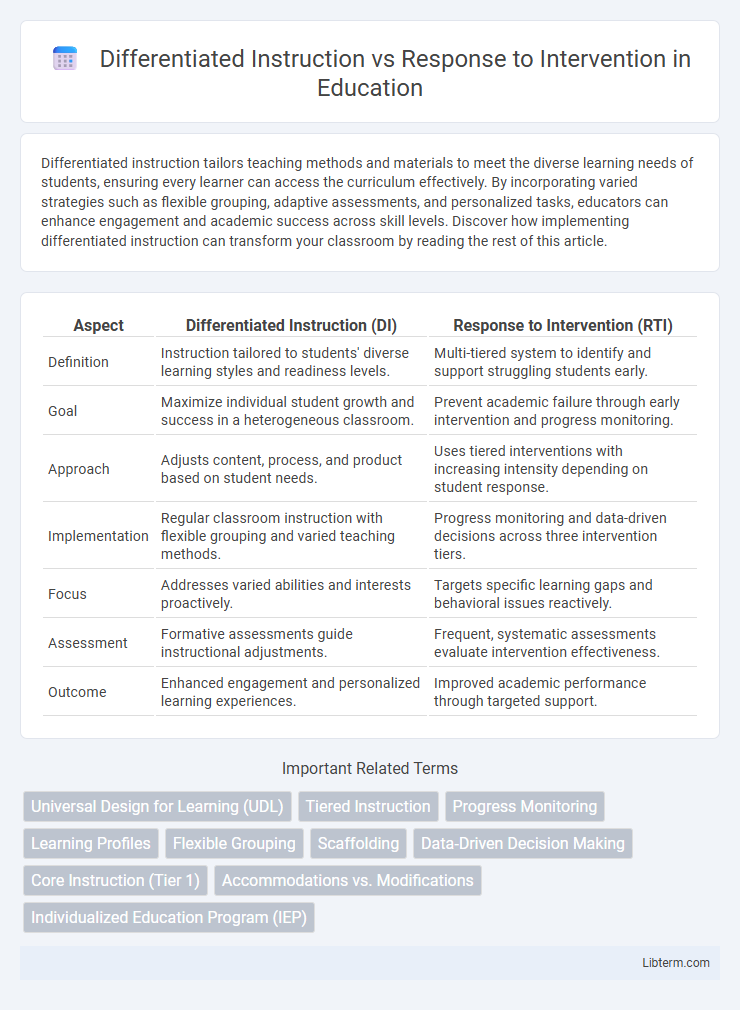Differentiated instruction tailors teaching methods and materials to meet the diverse learning needs of students, ensuring every learner can access the curriculum effectively. By incorporating varied strategies such as flexible grouping, adaptive assessments, and personalized tasks, educators can enhance engagement and academic success across skill levels. Discover how implementing differentiated instruction can transform your classroom by reading the rest of this article.
Table of Comparison
| Aspect | Differentiated Instruction (DI) | Response to Intervention (RTI) |
|---|---|---|
| Definition | Instruction tailored to students' diverse learning styles and readiness levels. | Multi-tiered system to identify and support struggling students early. |
| Goal | Maximize individual student growth and success in a heterogeneous classroom. | Prevent academic failure through early intervention and progress monitoring. |
| Approach | Adjusts content, process, and product based on student needs. | Uses tiered interventions with increasing intensity depending on student response. |
| Implementation | Regular classroom instruction with flexible grouping and varied teaching methods. | Progress monitoring and data-driven decisions across three intervention tiers. |
| Focus | Addresses varied abilities and interests proactively. | Targets specific learning gaps and behavioral issues reactively. |
| Assessment | Formative assessments guide instructional adjustments. | Frequent, systematic assessments evaluate intervention effectiveness. |
| Outcome | Enhanced engagement and personalized learning experiences. | Improved academic performance through targeted support. |
Introduction to Differentiated Instruction and Response to Intervention
Differentiated Instruction tailors teaching methods and materials to meet diverse student needs, enhancing learning outcomes through personalized strategies. Response to Intervention (RTI) implements a multi-tiered approach to identify struggling students early and provide targeted supports to prevent academic failure. Both frameworks prioritize proactive, data-driven instruction to optimize student achievement and engagement.
Defining Differentiated Instruction
Differentiated instruction is a teaching approach tailored to meet the diverse learning needs, readiness levels, and interests of students within a single classroom by varying content, process, and products. It emphasizes proactive lesson planning to accommodate individual differences and promote equitable access to curriculum. This strategy contrasts with Response to Intervention (RTI), which primarily focuses on identifying and supporting students with learning difficulties through targeted interventions after initial instruction.
Understanding Response to Intervention
Response to Intervention (RTI) is a multi-tiered approach designed to identify and support students with learning difficulties through increasingly intensive interventions based on continuous progress monitoring. It emphasizes early detection and systematic delivery of evidence-based instruction tailored to individual student needs before considering special education services. RTI integrates assessment and instruction to prevent academic failure, making it a proactive framework within the general education setting.
Core Principles of Differentiated Instruction
Differentiated Instruction centers on tailoring teaching methods, content, and assessment to meet diverse student needs within a heterogeneous classroom, emphasizing flexible grouping, ongoing assessment, and varied instructional strategies. Core principles include recognizing student readiness, interests, and learning profiles to create personalized learning experiences that maximize engagement and achievement. Unlike Response to Intervention, which primarily targets struggling learners through tiered support, Differentiated Instruction aims to proactively address learning variability for all students.
Key Components of Response to Intervention
Response to Intervention (RTI) centers on key components such as multi-tiered instruction, continuous progress monitoring, and data-driven decision making to support struggling students. Differentiated Instruction customizes teaching methods and materials to meet diverse learner needs within the classroom, whereas RTI provides targeted interventions based on ongoing assessment data. RTI's structured framework includes universal screening, targeted interventions, and frequent progress evaluations to ensure effective academic support.
Comparing Goals: Differentiation vs Intervention
Differentiated Instruction aims to tailor teaching strategies to accommodate diverse student learning styles and abilities within the general education classroom, fostering inclusive academic growth. Response to Intervention (RTI) focuses on identifying and supporting students with learning difficulties through targeted interventions and progress monitoring to prevent failure. While Differentiation promotes proactive customization for all learners, RTI provides reactive, structured support to students struggling academically.
Classroom Implementation Strategies
Differentiated Instruction strategies in the classroom involve tailoring content, process, and product based on students' diverse readiness levels, interests, and learning profiles to maximize engagement and growth. Response to Intervention (RTI) employs a multi-tiered approach where evidence-based interventions are systematically applied, monitored, and adjusted to address students' academic and behavioral needs. Effective classroom implementation of both methods requires ongoing progress monitoring, flexible grouping, data-driven decision making, and collaboration among educators to ensure targeted support and inclusive learning environments.
Assessment in Differentiated Instruction and RTI
Assessment in Differentiated Instruction involves ongoing formative evaluations tailored to individual student needs, enabling teachers to adjust content, process, and product based on student readiness, interests, and learning profiles. Response to Intervention (RTI) uses a tiered assessment model to identify at-risk students through universal screening, progress monitoring, and targeted interventions aimed at mitigating learning difficulties before they escalate. Both frameworks rely on data-driven decisions, but Differentiated Instruction emphasizes personalized assessment for diverse learners, while RTI focuses on systematic identification and support within a multi-tiered system of support.
Benefits and Challenges of Each Approach
Differentiated Instruction benefits students by tailoring teaching methods and content to diverse learning styles and readiness levels, enhancing engagement and retention, but challenges include the demand for extensive teacher planning and resource allocation. Response to Intervention (RTI) offers a systematic, data-driven approach for identifying and supporting struggling students early, reducing the risk of academic failure; however, it requires consistent progress monitoring and can strain school resources with its multi-tiered support system. Both approaches emphasize personalized learning; differentiated instruction excels in classroom-level customization, while RTI provides structured interventions based on student performance data.
Integrating Differentiated Instruction with RTI
Integrating Differentiated Instruction (DI) with Response to Intervention (RTI) creates a dynamic educational framework that addresses diverse learner needs through tiered support and personalized teaching strategies. DI enhances RTI by providing tailored content, process, and product modifications within each intervention tier, ensuring that instruction meets students' readiness levels, interests, and learning profiles. This synergy maximizes student engagement and achievement by systematically combining proactive differentiation with data-driven intervention monitoring.
Differentiated Instruction Infographic

 libterm.com
libterm.com